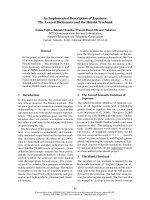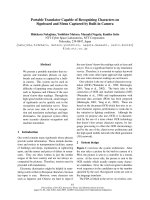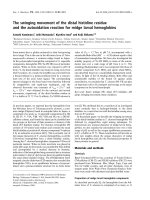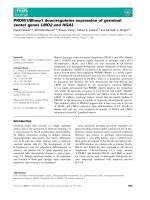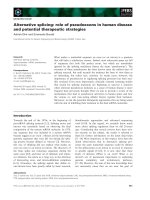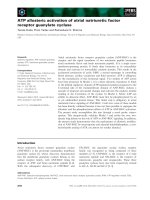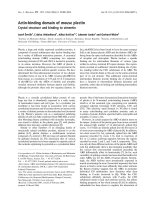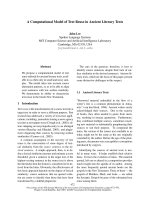Báo cáo khoa học: PRDM1/Blimp1 downregulates expression of germinal center genes LMO2 and HGAL pot
Bạn đang xem bản rút gọn của tài liệu. Xem và tải ngay bản đầy đủ của tài liệu tại đây (402.91 KB, 11 trang )
PRDM1/Blimp1 downregulates expression of germinal
center genes LMO2 and HGAL
Elena Cubedo
1,
*, Michelle Maurin
2,
*, Xiaoyu Jiang
1
, Izidore S. Lossos
1,
and Kenneth L. Wright
2,
1 Department of Medicine and Molecular and Cellular Pharmacology, Sylvester Comprehensive Cancer Center, University of Miami, FL, USA
2 Immunology Program, H. Lee Moffitt Cancer Center and Research Institute, Tampa, FL, USA
Keywords
Blimp-1; HGAL; LMO2; non-Hodgkin’s B-cell
lymphoma; transcription
Correspondence
K. L. Wright, H. Lee Moffitt Cancer Center,
MRC4E, 12902 Magnolia Drive, Tampa,
FL 33612, USA
Fax: +1 813 745 7264
Tel: +1 813 745 3918
E-mail: ken.wright@moffitt.org
Note
*, these sets of authors contributed
equally to this work
(Received 26 April 2011, revised 23 May
2011, accepted 28 June 2011)
doi:10.1111/j.1742-4658.2011.08227.x
Human germinal center-associated lymphoma (HGAL) and LIM domain
only-2 (LMO2) are proteins highly expressed in germinal center (GC)
B lymphocytes. HGAL and LMO2 are also expressed in GC-derived
lymphomas and distinguish biologically distinct subgroups of diffuse large
B-cell lymphomas (DLBCL) associated with improved survival. However,
little is known about their regulation. PRDM1 ⁄ Blimp1 is a master regula-
tor of terminal B cell differentiation and may also function as a tumor sup-
pressor in the pathogenesis of DLBCL, where it is frequently inactivated
by mutations and deletions. We now demonstrate that both HGAL and
LMO2 are directly regulated by the transcription repressor PRDM1.
In vivo studies demonstrate that PRDM1 directly binds to the recognition
sites within the upstream promoters of both HGAL and LMO2. PRDM1
binding suppresses endogenous protein and mRNA levels of HGAL and
LMO2. In addition, promoter analysis reveals that site-specific binding of
PRDM1 to the promoters is capable of repressing transcriptional activity.
This inhibitory effect of PRDM1 suggests that it has a key role in the loss
of HGAL and LMO2 expression upon differentiation of GC B cells to
plasma cells and may also contribute to absence of HGAL and LMO2
expression in post-GC lymphoid tumors.
Introduction
Germinal center (GC) reaction is a highly regulated
critical step in the generation of humoral immunity. It
is characterized by B-cell proliferation, immunoglobu-
lin affinity maturation leading to antigen selection,
immunoglobulin class-switch, and finally differentia-
tion of B cells into either memory cells or antibody
secreting plasma cells [1]. The development of GC
B lymphocytes and the subsequent differentiation to
memory and plasma cells is tightly regulated and is
associated with characteristic changes in gene expres-
sion [2,3]. Despite significant studies on the regulation
and function of these gene changes, many important
regulatory steps remain to be deciphered.
Gene expression profiling previously identified two
genes encoding proteins highly expressed in GC B lym-
phocytes: human germinal center-associated lymphoma
(HGAL), also known as germinal center-expressed
transcript 2, and LIM domain only-2 (LMO2) [4,5].
Both genes are induced in GC B cells and silenced dur-
ing differentiation into plasma cells or memory B cells.
HGAL and LMO2 are also expressed in GC-derived
lymphomas. Characterization of a large number
of DLBCL has identified HGAL and LMO2 as mark-
ers which can be used to distinguish biologically dis-
tinct subgroups associated with improved survival
[4,6–10].
Abbreviations
ChIP, chromatin immunoprecipitation; DLBCL, diffuse large B-cell lymphomas; GC, germinal center; HGAL, human germinal center-
associated lymphoma; LIMO2, LIM domain only-2; PRDM1, PR domain containing 1.
FEBS Journal 278 (2011) 3065–3075 ª 2011 The Authors Journal compilation ª 2011 FEBS 3065
The HGAL gene, located on chromosome 3q13,
encodes a 178-amino-acid protein with 51% identity
and 62% similarity to the murine M17 protein, both
exclusively expressed in GC B lymphocytes [6]. Studies
in mice revealed that M17 is dispensable for GC
formation, immunoglobulin somatic hypermutation,
class-switch recombination, and for mounting T-cell-
dependent antibody responses [11]. However, in
contrast to their wild-type littermates, M17-deficient
mice exhibited reduced-sized Peyer patches [11]. Recent
studies showed that HGAL is involved in motility
regulation of GC B cells and GC-derived malignant
lymphoma cells. It inhibits interleukin-6 and SDF-1-
induced migration of malignant lymphoma cells and
normal GC B lymphocytes by interacting with actin
and myosin proteins [12,13] as well as by regulating the
RhoA signaling pathway [12,14]. HGAL induces activa-
tion of RhoA and its downstream effectors by directly
binding and activating the RhoA-specific guanine nucle-
otide exchange factors PDZ-RhoGEF and LARG. This
stimulates the GDP–GTP exchange rate of RhoA and
results in inhibition of lymphocyte and lymphoma cell
motility, induction of transcriptional activation
by serum response factor and amplification of RhoA
transforming potential [14].
LMO2 gene, located on the short arm of chromosome
11 at band 13 (11p13), is a member of the LIM-only
zinc finger protein family and mediates protein–protein
interaction in multiprotein transcriptional factor com-
plexes. It was discovered from a recurrent translocation
in T-cell acute lymphoblastic leukemia, but its expres-
sion is extinguished early in T-cell development and is
not required for normal development of this lineage
[15]. Aberrant expression of LMO2 in immature T cells
in the thymus leads to thymocyte self-renewal [16], accu-
mulation of early lymphoid precursors and oncogenic
transformation, leading to childhood T-cell acute lym-
phoblastic leukemia. LMO2 plays an important role in
normal endothelial and hematopoietic cells. In the endo-
thelial system, it is involved in angiogenesis, playing a
critical role in the angiogenetic remodeling of the vascu-
lature [17]. In the hematopoietic system, LMO2 expres-
sion is restricted to adult hematopoietic stem cells and
the erythroid lineage [18] and it is essential for yolk sac
erythropoiesis [19]. Chimeric animals produced from
homozygous-deficient embryonic stem cells demon-
strated abnormal hematopoiesis. We have recently
observed specific upregulation of LMO2 expression in
GC B lymphocytes and GC-derived DLBCL [2,5], but
its function in these cells is still unknown.
B-lymphocyte differentiation into plasma cells is
dependent on the transcription factor PR domain con-
taining 1, with zinc finger domain 1 (PRDM1), also
known as Blimp1. PRDM1 encodes a zinc finger tran-
scriptional repressor described by Turner et al. [20] as
an inducer of B-cell differentiation. PRDM1 also has a
key role in regulating the effector function of T cells
[21–24] and natural killer cells [25,26]. Stimulation of
macrophages and dendritic cells through Toll-like
receptors also induces PRDM1 expression, suggesting
that PRDM1 has a role in regulating multiple immune
cell types [27,28]. PRDM1 functions as a transcription
repressor by directly binding DNA and acting as a
scaffold to recruit multiple corepressor proteins includ-
ing the histone H3 methyltransferase, G9a [29], the his-
tone deacetylase HDAC2 [30], the arginine
methyltransferase PRMT5 [31] and the histone de-
methylase LSD1 [32]. In addition, at some gene tar-
gets, PRDM1 may displace transcriptional activators
of the interferon regulatory factor family through
DNA binding site competition [33].
In B lymphocytes, PRDM1 is required for the for-
mation of plasma cells [34]. Conditional knockout of
PRDM1 in the B-cell compartment leads to an accu-
mulation of activated B cells and a loss of plasma cell
differentiation [35,36]. Conversely, enforced expression
of PRDM1 in lymphoma cell lines promotes either par-
tial differentiation or induction of apoptosis [37].
PRDM1 acts as a tumor suppressor in activated B-cell-
like DLBCL, where it is inactivated through multiple
mechanisms [38–41]. Gene expression profiling demon-
strates that PRDM1 coordinates significant reprogram-
ming of the genes expressed in GC B lymphocytes [42].
A limited number of these reprogrammed genes have
been identified as direct targets of PRDM1 repression.
These include genes required for maintaining the B-cell
phenotype and in maintaining cellular proliferation, for
example, CIITA, PAX5, Spi-B, Id3 and c-myc [42–46].
In addition, we have recently identified the proliferation
genes PCNA and MKI67 as functionally important
direct targets of PRDM1 during mantle cell lymphoma
therapy [47]. Together these studies have identified
PRDM1 as a key regulatory step in the transition from
a GC B lymphocyte to a plasma cell; however, many of
the functionally important direct targets of PRDM1 in
this process remain to be deciphered. This study now
establishes HGAL and LMO2 as two GC proteins
whose expression is directly regulated by PRDM1.
Results
PRDM1 overexpression suppresses endogenous
LMO2 and HGAL expression
Gene expression profiling previously performed by us
[2] reveals that expression of HGAL and LMO2 is
PRDM1 repression of LMO2 and HGAL E. Cubedo et al.
3066 FEBS Journal 278 (2011) 3065–3075 ª 2011 The Authors Journal compilation ª 2011 FEBS
downregulated concomitant with induction of PRDM1
during differentiation of human GC lymphocytes to
plasma and memory B cells (Fig. 1). Consequently, we
hypothesized that PRDM1 may regulate the expression
of these genes. To address this question, B-cell lym-
phoma cell lines expressing endogenous HGAL and
LMO2 proteins were transfected with a PRDM1
expression construct and the changes in mRNA and
protein were profiled. Immunoblot analysis of the
B-cell lymphoma cell line, VAL, revealed that both
HGAL and LMO2 protein expression decrease in a
dose-dependent manner with the increase of PRDM1
(Fig. 2A). Similarly, the known PRDM1 target, BCL6,
also showed dose-dependent suppression by PRDM1.
This finding was also observed in the B-lymphoma cell
line, Raji (Fig. 2B). Expression changes at the level of
mRNA were analyzed by quantitative reverse tran-
scription PCR (Fig. 2C,D). Twenty-four hours after
PRDM1 transfection, HGAL and LMO2 mRNA lev-
els are suppressed up to 40% in both the VAL and
Raji B lymphoma cell lines. The level of suppression is
similar to the degree observed with BCL6, a known
PRDM1 target. Overall, these results show that ectopic
expression of PRDM1 in GC-derived lymphoma cell
lines downregulates endogenous mRNA and protein
expression of both HGAL and LMO2.
PRDM1 binds the HGAL and LMO2 promoters
in vivo
The effect of PRDM1 on HGAL and LMO2 expres-
sion could be through direct or indirect transcriptional
suppression of these genes. PRDM1 is a direct DNA-
binding transcription repressor which recognizes the
sequence 5¢-MAGYGAAAYK-3¢ [33]. Bioinformatic
search of the HGAL promoter revealed two potential
homologies to this sequence located at positions )1608
and )1383 upstream of the transcription initiation site.
A similar search of the LMO2 promoter region pre-
dicted only one site of high homology at position
)1783 relative to the transcription start site. The pres-
ence of PRDM1 bound at these promoter regions was
determined through chromatin immunoprecipitation
from myeloma cell lines which represent differentiated
plasma cells and express PRDM1. Robust PRDM1
interaction was observed at the LMO2 promoter in the
myeloma cell line NCI-H929 (Fig. 3A) and in the mye-
loma cell line U266 (data not shown). The interaction
is highly specific as revealed by the minimal signal
obtained with the control antibody. Furthermore the
HLA-DRA promoter which we have previously shown
not to bind PRDM1 displayed minimal signal intensity
[28]. By contrast, the PCNA promoter, which has been
previously demonstrated to bind PRDM1 with very
high intensity, clearly shows binding similar to that
observed with LMO2 [47]. Chromatin immunoprecipi-
tation (ChIP) was also carried out at the HGAL pro-
moter (Fig. 3B). Similar to the LMO2 results,
significant PRDM1 binding was clearly detected at the
HGAL promoter in the region of the predicted
PRDM1 binding sites. The intensity of binding was
approximately sevenfold less than observed at LMO2
but remained significantly stronger than either the neg-
ative control promoter, HLA-DRA, or the negative
control antibody. These findings reveal that endoge-
nous PRDM1 is bound to both LMO2 and HGAL
promoters and thus can directly act to suppress these
genes.
PRDM1 directly regulates the HGAL and LMO2
promoters
PRDM1 regulates its target genes at the level of tran-
scription. Thus to functionally determine whether
PRDM1 is a physiological regulator of HGAL and
PRDM1
LMO2
HGAL
Tonsil GC B cells
Tonsil GC centroblasts
Blood memory B cells, CD27+
Blood B cells + anti-IgM 6 h
2 1 0
–1–2
4.0002.0001.000
0.5000.250
Fig. 1. Reciprocal expression of LMO2 and HGAL with PRDM1 in
primary B cells. PRDM1, LMO2 and HGAL mRNA expression was
analyzed by cDNA microarrays as reported previously [2] in GC
B cells and centroblasts, memory B cells and peripheral B lympho-
cytes stimulated for 6 h with anti-IgM. The results show the ratio
of hybridization of fluorescent cDNA probes prepared from each
experimental mRNA sample to a reference mRNA sample. These
ratios are a measure of relative gene expression in each experimen-
tal sample and are depicted according to the color scale shown at
the bottom.
E. Cubedo et al. PRDM1 repression of LMO2 and HGAL
FEBS Journal 278 (2011) 3065–3075 ª 2011 The Authors Journal compilation ª 2011 FEBS 3067
LMO2 transcription we cloned the promoters of both
genes. A region of the LMO2 promoter from )2591 to
+629 bp relative to the transcription initiation site
was inserted into a luciferase reporter construct to cre-
ate 2591LMO2–Luc (Fig. 4A). Transfection of this
full-length, wild-type LMO2 promoter into the Raji
B-lymphoma cell line demonstrated that this region is
sufficient to promote robust transcription, similar to
the well-characterized CIITA promoter [48]. Cotrans-
fection of a PRDM1 expression construct results in an
30% repression of LMO2 promoter activity
(Fig. 4B). The level of suppression is similar to that
observed with the CIITA luciferase construct, which
we have previously characterized as a direct target of
PRDM1 [43]. LMO2 repression by PRDM1 was fully
abrogated by either site-directed mutagenesis of the
predicted PRDM1 binding site (Mutant-LMO2) or 5¢
deletion of the PRDM1 binding region (920LMO2).
These findings were confirmed in a second B-lym-
phoma cell line, CA46 (data not shown).
Similar analysis of the HGAL promoter was per-
formed. The region of )1950 to +96 of the HGAL
promoter relative to the transcription start site was
cloned into a luciferase reporter construct (Fig. 4A).
Three additional constructs were created in which the
predicted PRDM1 binding sites were disrupted by
site-directed mutagenesis, either individually or simul-
taneously. Cotransfection of the wild-type HGAL pro-
moter with the PRDM1 expression construct led to
70% repression of HGAL promoter activity in Raji
cells (Fig. 4C) and 30% repression in HeLa cells (data
not shown). Individual mutations of each of the two
AB
D
Raji Val
++
Control
PRDM1α
––
++
––
PRDM1α
Actin
0
10
20
30
***
***
PRDM1α
Relative mRNA
C
BCL6LMO2
0
0.2
0.4
0.6
0.8
1
1.2
Val Raji Val Raji Val Raji
HGAL
*
**
**
**
*
*
Relative mRNA
15
Control
PRDM1α
HGAL
LMO2
Actin
PRDM1α
–
15
–
1.0 0.7
1.0 0.7
15
Control
PRDM1α
BCL6
HGAL
LMO2
Actin
PRDM1α
–
–
1.0 1.2
1.0 0.4 0.8 0.1
1.0 0.5 0.8 0.2
1.0 0.5 0.8 0.3
20
15
–
20
–
Fig. 2. LMO2 and HGAL mRNA and protein
levels are decreased by PRDM1. Lymphoma
cell lines, VAL (A) and Raji (B) were trans-
fected with 15 or 20 lg of a PRDM1a
expression plasmid or empty vector control
as indicated at the top of the panel. Forty-
eight hours after transfection cellular pro-
teins were resolved by SDS ⁄ PAGE and
immunoblot analysis performed with the
antibodies specific for the proteins indicated
on the right side of each panel. The relative
intensity of each band was determined by
densitometry, normalized to the actin load-
ing control and the value is shown below
each lane. PRDM1 expression correlated
with a decrease in HGAL and LMO2. BCL6
is a positive control for PRDM1-mediated
repression and actin is a loading control.
The result is representative of three inde-
pendent experiments. (C) Lymphoma cell
lines, VAL and Raji, were transfected with
15 lg of a PRDM1a expression plasmid or
empty vector control and the mRNA levels
were measured using quantitative RT-PCR.
The data shown represents three indepen-
dent experiments with the error bars repre-
senting the SD and P-values indicated by
asterisks (**P < 0.003, *P < 0.03). (D)
Quantitation of PRDM1 mRNA and protein
levels in the same experiment shown in
panel C (***P <3· 10
)7
).
PRDM1 repression of LMO2 and HGAL E. Cubedo et al.
3068 FEBS Journal 278 (2011) 3065–3075 ª 2011 The Authors Journal compilation ª 2011 FEBS
PRDM1 binding sites in the HGAL promoter partially
reduced the degree of repression by PRDM1. Con-
comitant mutation of both PRDM1 binding sites in
the HGAL promoter completely reversed the inhibitory
effect of PRDM1 on the HGAL promoter. Together,
these findings demonstrate that the predicted PRDM1
binding sites in the LMO2 and HGAL promoters are
functional sites of PRDM1 mediated repression.
Discussion
This study demonstrates that PRDM1 regulates the
GC and GC-DLBCL marker genes, HGAL and
LMO2. The repression mediated by PRDM1 is
through direct binding to consensus elements present
in the upstream region of both promoters. Repression
is reflected by decreases in both endogenous mRNA
and protein. Furthermore, transcriptional activity from
both promoters is specifically inhibited in the presence
of PRDM1. These findings identify two novel genes
highly and specifically expressed in GC B cells that are
downregulated by PRDM1 upon transition from GC
B lymphocytes to a differentiated plasma cell.
Although the full functional spectrum of HGAL and
LMO2 in the GC reaction is still unknown, future
studies will most probably elucidate the importance of
their downregulation by PRDM1 for success of the
terminal differentiation process. Furthermore, because
PRDM1 is a tumor suppressor gene, downregulation
of HGAL and LMO2 may also play a role in guarding
against malignant transformation.
Previous studies showed that PRDM1 may increase
migration of breast cancer cells [49]. Repression of
HGAL by PRDM1 identifies the first mechanistic link
between B-cell migration and PRDM1. HGAL
through interaction with RhoA specific guanine nucle-
otide exchange factors inhibits B-cell motility [12,14].
Thus PRDM1 has the potential to release the inhibi-
tion and promote B-cell migration. This might be
physiologically important in a normal GC to allow the
differentiating B cells to egress out of the GC. In
DLBCL patients, HGAL expression is associated with
improved survival [4,6,7]. This suggests that PRDM1
repression of HGAL may be an important regulatory
step contributing to the clinical outcome. Despite the
growing importance of HGAL little is known about
the regulation of its expression. Interleukin-4 stimula-
tion upregulates HGAL expression and Sp1⁄ Sp3 can
activate HGAL transcription, but the specific tran-
scription factors that control HGAL expression are
poorly understood [6,50]. Investigations of the activa-
tion mechanisms and how PRDM1 counteracts activa-
tion will provide important insight into this important
regulatory process.
LMO2 is a nuclear protein which can participate in
the formation of DNA binding complexes which inter-
act with E-proteins, E12 and E47 [51]. Specific genes
regulated by LMO2 in B lymphocytes are not known.
However, a clear correlation between LMO2 expres-
sion and better overall survival in DLBCL patients has
been documented [10]. Interestingly, many of the iden-
tified direct targets of PRDM1 including LMO2 are
involved in transcriptional activation. This suggests
that PRDM1 effects on gene expression reprogram-
ming during B-cell differentiation are significantly
amplified by a cascade of both direct and indirect
gene silencing. Furthermore, LMO2 transcriptional
repression by PRDM1 in lymphocytes may have
important implications for lymphoma pathogenesis.
0.00
0.05
0.10
0.15
0.20
0.25
LMO2 HLA-DRA PCNA
%input
P = 0.0002
P = 0.009
A
0.000
0.005
0.010
0.015
0.020
0.025
%input
HGAL HLA-DRA
P = 0.05
BC
Raji
PRDM1
Actin
NCI-
H929
Fig. 3. PRDM1 binds to the LMO2 and HGAL promoters in vivo.
ChIP analysis was performed from the myeloma cell line, NCI-
H929, expressing endogenous PRDM1. ChIP analysis was per-
formed with both the specific PRDM1 antibody (black bars) and an
IgG negative control antibody (white bars). Binding to the promoter
regions were assessed by quantitative PCR using primers proximal
to the predicted PRDM1 binding sites in the LMO2 promoter (A)
and the HGAL promoter (B). The HLA-DRA promoter was evaluated
as a known negative control for PRDM1 binding. The PCNA pro-
moter represents a known positive site of PRDM1 binding. The
data are presented as percent input and the error bars represent
the SEM of three independent experiments. P-values are indicated.
Expression of PRDM1 protein in the NCI-H929 cell line was con-
firmed by immunoblot analysis (C).
E. Cubedo et al. PRDM1 repression of LMO2 and HGAL
FEBS Journal 278 (2011) 3065–3075 ª 2011 The Authors Journal compilation ª 2011 FEBS 3069
Fig. 4. PRDM1 directly regulates the LMO2
and HGAL promoters. (A) Schematic of the
LMO2 and HGAL luciferase constructs.
Black boxes indicate location of the PRDM1
binding sites and the X indicates the
sequence has been mutated to prevent
PRDM1 binding. Bent arrow indicates the
transcription start site. (B) Luciferase
analysis of the LMO2 promoter constructs
in the Raji B lymphoma cell line. Promoter
constructs indicated at the bottom were
cotransfected with either a PRDM1 expres-
sion plasmid or the control pCDNA plasmid
as indicated. The results within each trans-
fection are normalized to the cotransfected
pRL-TK signal. The CIITA-luciferase con-
struct is a known PRDM1 target and is
shown as a positive control. The results
presented represent three independent
experiments with the error bars indicating
the SD. P-values are shown. (C) Luciferase
analysis of the HGAL promoter constructs in
the Raji B lymphoma cell line. The experi-
ment is as described in (B) and the con-
structs are shown in (A). The results
presented represent three independent
experiments with the error bars indicating
the SD. P-values are shown.
PRDM1 repression of LMO2 and HGAL E. Cubedo et al.
3070 FEBS Journal 278 (2011) 3065–3075 ª 2011 The Authors Journal compilation ª 2011 FEBS
PRDM1 has been demonstrated to function as a
tumor suppressor in DLBCL. This effect is mediated
by suppression of BCL-6 oncogene and probably addi-
tional presently unknown oncogenes. LMO2 is a
known T-cell oncogene that also may function as a
B-cell oncogene. Studies in B cells aimed to identify
genes regulated by LMO2 and examining its oncoge-
neic role are currently ongoing and will reveal both the
role of LMO2 and elucidate the activity of PRDM1 in
this lineage.
Several reports have begun to characterize the func-
tional promoter of LMO2 [18,52–54]. The gene con-
tains three potential promoters which generate
transcripts with distinct 5¢ untranslated regions but
include the complete protein encoding exons 4–6 and
thus result in identical proteins. The promoter which
starts transcription at exon 1, referred to as the distal
promoter, conveys tissue-specific activity and is the
site of activity in hematopoietic cells. By contrast, a
promoter located upstream of exon 4, referred to as
the proximal promoter, is active in a broad range of
cell types. The distal promoter is activated by factors
of the proline and acidic amino acid-rich protein fam-
ily binding downstream of the transcription initiation
site [52]. Recently, an intermediate promoter was
shown to be active in T-cell acute lymphoblastic leu-
kemia [54]. This promoter is activated by the ETS fac-
tors, ERG1 and FLI1. Long-range mapping of
histone acetylation and transcription factors recently
identified eight conserved elements across 250 kb of
the LMO2 locus potentially involved in the hemato-
poietic expression of LMO2 [18] and functional
domains in T-cell acute lymphoblastic leukemia and
B-cell acute lymphoblastic leukemia [54]. Binding of
several factors to the hematopoietic enhancers was
detected including Gata2, Tal1 and LMO2 itself.
Interestingly, a negative regulatory region was
reported in the T-cell line, Jurkat [53]. The element
was resolved to a 205 bp region, however, the specific
element and factor were not able to be identified. This
region spans the PRDM1 binding site characterized in
this report. This finding is consistent with our data in
B lymphocytes and suggests that PRDM1 may have a
similar role as a suppressor of LMO2 in acute T-cell
leukemia cells. The conclusion that LMO2 is directly
regulated by PRDM1 is also supported by a recent
study utilizing ChIP combined with microarray
hybridization (ChIP-on-chip) [55]. This report identi-
fied LMO2 as a potential gene downregulated by
PRDM1 in the myeloma cell line, U266. Our func-
tional characterization of the LMO2 promoter and
specific PRDM1 interaction site in B cells significantly
expands this observation.
In conclusion, these findings demonstrate that
PRDM1 is a physiological transcriptional repressor of
the expression of LMO2 and HGAL genes. This inhibi-
tory effect may mediate the loss of HGAL and LMO2
expression upon differentiation of GC B cells to plasma
cells and may contribute, in addition to other currently
unknown factors, to the absence of HGAL and LMO2
expression in post-GC lymphoid tumors. It is also pos-
sible that the tumor suppressor effect of PRDM1 is at
least partially mediated by repression of LMO2 and
HGAL genes, which are highly expressed in a subset of
DLBCL and potentially have an important role in the
pathogenesis of this malignancy. Now that this regula-
tory pathway has been identified it will be important to
define the role of PRDM1 inhibition of HGAL and
LMO2 in the pathogenesis and outcome of DLBCL.
Materials and methods
Cell lines and protein accession numbers
Human non-Hodgkin lymphoma cell lines VAL (diffuse
large B-cell lympnoma), Raji and CA-46 (Burkitt’s lym-
phoma) were maintained in RPMI medium (Invitrogen,
Grand Island, NY, USA) supplemented with 10% fetal
bovine serum (HyClone-Themo Scientific, Logan, UT,
USA) and 1% penicillin ⁄ streptomycin (Invitrogen) and
2mm glutamine (Invitrogen). NCI-H929, a multiple mye-
loma cell line with a plasma cell phenotype was maintained
as above with an additional 0.05 m b-mercaptoetanol (Invi-
trogen) supplement. Human cervical cancer cell line HeLa
was grown in Dulbecco’s modified Eagle’s medium (Invitro-
gen) similarly supplemented with 10% fetal bovine serum,
glutamine and penicillin ⁄ streptomycin. All cell lines were
cultured at 37 °C and 5% CO
2
. The Uniprot accession
numbers associated with the proteins used in this article
are: LMO2,
P25791; HGAL, Q8N6F7; PRDM1, O75626.
DNA constructs
Expression constructs for PRDM1a have been described
previously by Ghosh et al. [43]. The region consisting of
2591 bp upstream of the human LMO2 transcription initia-
tion site and 629 bp downstream was cloned by PCR into
the vector PCR2.1 (Invitrogen) using primers 5¢-GGC
TCGGCCTAAAACCTTC-3¢ and 5¢-GAAAGAGAAGCC
AGAGTGCC-3¢. The initiation site is based on data from
the NCBI genome annotation (build 37) and is 208 bp 5¢
of the previously reported site [52]. The BamHI–HindIII
fragment was then subcloned into the BglII–HindIII sites
of PGL3-Basic (Promega, Madison, WI, USA) to create
the 2591LMO2–Luc reporter plasmid. The construct
920LMO2–Luc was constructed by subcloning the HincII–
HindIII fragment from 2591LMO2–pCDNA2.1 into the
E. Cubedo et al. PRDM1 repression of LMO2 and HGAL
FEBS Journal 278 (2011) 3065–3075 ª 2011 The Authors Journal compilation ª 2011 FEBS 3071
SmaI–HindIII sites of pGL3-Basic. The LMO2-mutant
reporter plasmid was generated by site-directed mutagenesis
(Mutagenex, Inc. Piscataway, NJ, USA) of 2591LMO2-Luc
converting the predicted PRDM1 binding site at position
)1783 bp from 5¢-ACCCTCACTTTCATTTC-3¢ to 5¢-CCC
TCGTCGACATTTC-3¢. All constructs were confirmed by
sequencing.
The region consisting of 1950 bp upstream the human
HGAL transcription initiation site and 96 bp downstream
was amplified from the SUDHL-6 cell line by the PhusionÔ
High-Fidelity PCR Master Mix (Finnzymes Oy, Espoo, Fin-
land) using the primers HGAL-FWD 5¢-GGAAAGAGCTC
GAGTGACCAAACTGGAAACAAC-3¢ and HGAL-REV
5¢-GGGAAAGCTAGCT TGTGCTCTG ACAGGGCAAC-3 ¢.
PCR products were digested with SacI and NheI
(New England Biolabs, Beverly, MA, USA) and ligated into
the pGL3-Basic vector to create the 1950HGAL–Luc
construct. Mutagenesis of the predicted PRDM1 binding
sites at position )1608 and )1383 of the 1950HGAL–Luc
construct was performed using the QuickChange XL Site-
Directed Mutagenesis Kit (Stratagene, La Jolla, CA, USA).
Primers used for mutagenesis with mutations in lower case
are HGAL-mutant#1: 5¢-CACAGAAGGTAGGCTTTAAG
TCTGGTCGCGTGCT CGTAG TG TAATG CATTTG AGA
TTGATCCA-3¢ and 5¢-TGGATCAATCTCAAATGCATT
ACACTACGAGCACGCGACCAGACTTAAAGCCTACC
TTCTGTG-3¢ and for HGAL-mutant#2: 5¢-TATAAA
AATTTGTACACACAGTCTTAGAGGACATACGTGTG
TCGTGGCTAAATGCCTAGGAGTGAAATTGC-3¢ and
5¢-GCAATTTCACTCCTA GGCATTTAGC CAC GACAC
ACGTATGTCCTCTAAGACTGTGT GTACAAATTTT
TATA-3¢.
Transfections and luciferase assays
Non-Hogdkin’s lymphoma cell lines were transfected by
electroporation using either a BioRad Gene Pulser II (Bio-
Rad Laboratories, Hercules, CA, USA) or an Amaxa Nu-
cleofector II (Lonza, Walkersville, MD, USA). The Gene
Pulser conditions used 10
7
cells electroporated at 200 V and
1070 lF in 300 lL of RPMI supplemented with 10% fetal
bovine serum. The Nucleofector II conditions used 3 · 10
6
cells electroporated using program X-001 and solution V
for VAL cells and program M-013 and solution V for Raji
cells. Transfections for luciferase measurements were per-
formed with 10–15 lg of the luciferase reporter, 1.5 lgof
the PRDM1a expression vector or control pCDNA3.1 plas-
mid and 10 ng of the internal control plasmid pRL-TK
(Promega). Cells were cultured for 48 h after transfection in
10 mL of complete medium and subsequently harvested
into 100 lL Passive Lysis Buffer (Promega). HeLa cells
were transfected in triplicate using SiPort NeoFX (Ambion,
Austin, TX, USA) according to the manufacturer’s instruc-
tions. Briefly, 45 · 10
3
cells per well were seeded with
50 lL of transfection mix (1 lL of SiPort, 75 ng of
pRL-TK, 1.25 lg of the luciferase reporter plasmid, and
1 lg of the PRDM1a expression plasmid or control
pCDNA3.1 per well) in a final volume of 0.5 mL. Cells
were cultured for 48 h after transfection and harvested in
passive lysis buffer. All luciferase readings were performed
using the 20⁄ 20n luminometer (Turner Biosystems, Sunny-
vale, CA, USA). Firefly luciferase activity was normalized
to Renilla luciferase activity in all experiments.
Chromatin immunoprecipitation
Chromatin was prepared as previously described [56], and
1.5 · 10
6
cell equivalents were used in each immunoprecipi-
tation reaction. Primary antibodies were used at 0.5 lg per
reaction and incubated overnight. The antibodies used were
PRDM1 (PRDI-BF1) (Cell Signaling, Danvers, MA, USA)
and nonspecific rabbit IgG (Upstate-Millipore, Billerica,
MA, USA). RNA was removed from the immunoprecipi-
tated DNA by treatment with RNase (Ambion) for 30 min
at 37 °C and proteinase K (Roche) for 1 h at 45 °C. Col-
umn purification of the immunoprecipitated DNA was
done using the PCR purification kit (Qiagen, Valencia, CA,
USA). Analysis of the immunoprecipitated DNA was per-
formed by realtime PCR using SyberGreen (Quanta
Biosciences, Gaithersburg, MD, USA) in a CFX96 PCR
machine (BioRad Laboratories) The specific ChIP primers
are LMO2-Fwd: 5¢-TGGTGACTGCTGTGGGTAAG-3¢,
LMO2-Rev: 5¢-GCCCACTCACTCTTGCTTTC-3¢ and
HGAL-Fwd 5¢-GGAGTGAAATTGCCAGGTTG-3¢ and
HGAL-Rev 5¢-GAGAAGGGGTCAAGGGAACT-3¢.
Primers for ChIP analysis of the HLA-DRA promoter are
as reported previously [56]. Quality control was carried out
for each primer set which included optimization of anneal-
ing temperature, melt curve analysis to confirm amplifica-
tion of a single product and standard curve analysis to
confirm PCR efficiency was between 90 and 110%.
Immunoblotting
Cells were collected 48 h post-transfection and protein lev-
els were determined by immunoblot. Transfected cells were
washed once with ice-cold NaCl ⁄ P
i
and homogenized in
RIPA buffer (1· NaCl ⁄ P
i
, 1% Nonidet P-40, 0.5% sodium
deoxycholate, 0.1% SDS, 10 mm phenylmethanesulfonyl
fluoride, 1 lgÆmL
)1
aprotinin and 100 mm sodium ortho-
vanadate) on ice for 30 min. Cell lysates were centrifuged
at 14 000 g for 15 min at 4 °C to remove insoluble mate-
rial. Protein concentration of the lysates was determined
using a Bradford assay Coomasie Plus (Pierce, Rockford,
IL, USA). A total of 40 lg of whole-cell lysate per sample
was separated on 10% SDS ⁄ PAGE, transferred to polyv-
inylidene difluoride membranes (BioRad Laboratories), and
immunoblotted with specific antibodies. LMO2 and HGAL
monoclonal antibodies were produced in our laboratory as
previously reported [4,5], PRDM1 antibody was from Cell
PRDM1 repression of LMO2 and HGAL E. Cubedo et al.
3072 FEBS Journal 278 (2011) 3065–3075 ª 2011 The Authors Journal compilation ª 2011 FEBS
Signaling Technology, BCL6 antibody was from Santa
Cruz Biotechnology Inc (Santa Cruz, CA, USA) and
b-actin antibody was from Sigma-Aldrich (St. Louis, MO,
USA). Films were scanned and data subjected to densito-
metric analysis using scion image software (National Insti-
tutes of Health). Protein levels were normalized to the
corresponding loading controls and reported as ratios.
RNA isolation, reverse transcription, and
real-time PCR
Total cellular RNA was isolated from transfected cells
using the Trizol reagent (Invitrogen) according to the man-
ufacturer’s instructions. RNA (2 lg) was reverse tran-
scribed using the High-Capacity cDNA Archive kit
(Applied Biosystems, Foster City, CA, USA) according to
the manufacturer’s protocol and incubated at 25 °C for
10 min and 37 °C for 120 min. Real-time PCR measure-
ments were performed using the ABI PRISMs 7900HT
Sequence Detection System Instrument and software
(Applied Biosystems, Carlsbad, CA, USA), as previously
reported [9]. Commercially available Assays-on-Demand
(Applied Biosystems) were used for measurement of expres-
sion of LMO2, HGAL, BCL6 and PRDM1 and were nor-
malized to the 18S endogenous control.
Statistical methods
Quantitative RT-PCR, quantitative PCR and promoter-
luciferase assays were evaluated by two-tailed paired t-tests;
P-values are presented in each figure.
Acknowledgements
We wish to thank the staff of the Molecular Genomics
Core and Flow Cytometry Core at the H. Lee Moffitt
Cancer Center. KLW is supported by National Insti-
tutes of Health (NIH) grants CA080990 and ISL is
supported by NIH CA109335 and NIH CA122105, the
Dwoskin Family and Fidelity Foundations.
References
1 MacLennan IC (1994) Germinal centers. Annu Rev
Immunol 12, 117–139.
2 Alizadeh AA, Eisen MB, Davis RE, Ma C, Lossos IS,
Rosenwald A, Boldrick JC, Sabet H, Tran T, Yu X
et al. (2000) Distinct types of diffuse large B-cell lym-
phoma identified by gene expression profiling. Nature
403, 503–511.
3 Klein U, Tu Y, Stolovitzky GA, Keller JL, Haddad J Jr,
Miljkovic V, Cattoretti G, Califano A & Dalla-Favera R
(2003) Transcriptional analysis of the B cell germinal cen-
ter reaction. Proc Natl Acad Sci USA 100, 2639–2644.
4 Natkunam Y, Lossos IS, Taidi B, Zhao S, Lu X, Ding
F, Hammer AS, Marafioti T, Byrne GE Jr, Levy S
et al. (2005) Expression of the human germinal center-
associated lymphoma (HGAL) protein, a new marker
of germinal center B-cell derivation. Blood 105 , 3979–
3986.
5 Natkunam Y, Zhao S, Mason DY, Chen J, Taidi B,
Jones M, Hammer AS, Hamilton Dutoit S, Lossos IS &
Levy R (2007) The oncoprotein LMO2 is expressed in
normal germinal-center B cells and in human B-cell
lymphomas. Blood 109, 1636–1642.
6 Lossos IS, Alizadeh AA, Rajapaksa R, Tibshirani R &
Levy R (2003) HGAL is a novel interleukin-4-inducible
gene that strongly predicts survival in diffuse large
B-cell lymphoma. Blood 101, 433–440.
7 Azambuja D, Lossos IS, Biasoli I, Morais JC, Britto L,
Scheliga A, Pulcheri W, Natkunam Y & Spector N
(2009) Human germinal center-associated lymphoma
protein expression is associated with improved failure-
free survival in Brazilian patients with classical Hodgkin
lymphoma. Leuk Lymphoma 50, 1830–1836.
8 Durnick DK, Law ME, Maurer MJ, Natkunam Y,
Levy R, Lossos IS, Kurtin PJ & McPhail ED (2010)
Expression of LMO2 is associated with t(14;18) ⁄ IGH-
BCL2 fusion but not BCL6 translocations in diffuse
large B-cell lymphoma. Am J Clin Pathol 134, 278–281.
9 Lossos IS, Czerwinski DK, Alizadeh AA, Wechser
MA, Tibshirani R, Botstein D & Levy R (2004) Pre-
diction of survival in diffuse large-B-cell lymphoma
based on the expression of six genes. N Engl J Med
350, 1828–1837.
10 Natkunam Y, Farinha P, Hsi ED, Hans CP, Tibshirani
R, Sehn LH, Connors JM, Gratzinger D, Rosado M,
Zhao S et al. (2008) LMO2 protein expression predicts
survival in patients with diffuse large B-cell lymphoma
treated with anthracycline-based chemotherapy with
and without rituximab. J Clin Oncol 26, 447–454.
11 Christoph T, Rickert R & Rajewsky K (1994) M17:a
novel gene expressed in germinal centers. Int Immunol
6, 1203–1211.
12 Lu X, Chen J, Malumbres R, Cubedo Gil E, Helfman
DM & Lossos IS (2007) HGAL, a lymphoma prognos-
tic biomarker, interacts with the cytoskeleton and medi-
ates the effects of IL-6 on cell migration. Blood 110,
4268–4277.
13 Lu X, Kazmierczak K, Jiang X, Jones M, Watt J, Helf-
man DM, Moore JR, Szczesna-Cordary D & Lossos IS
(2011) Germinal center-specific protein human germinal
center associated lymphoma directly interacts with both
myosin and actin and increases the binding of myosin
to actin. FEBS J 278, 1922–1931.
14 Jiang X, Lu X, McNamara G, Liu X, Cubedo E, Saro-
siek KA, Sanchez-Garcia I, Helfman DM & Lossos IS
(2010) HGAL, a germinal center specific protein,
E. Cubedo et al. PRDM1 repression of LMO2 and HGAL
FEBS Journal 278 (2011) 3065–3075 ª 2011 The Authors Journal compilation ª 2011 FEBS 3073
decreases lymphoma cell motility by modulation of the
RhoA signaling pathway. Blood 116, 5217–5227.
15 McCormack MP, Forster A, Drynan L, Pannell R &
Rabbitts TH (2003) The LMO2 T-cell oncogene is acti-
vated via chromosomal translocations or retroviral
insertion during gene therapy but has no mandatory
role in normal T-cell development. Mol Cell Biol 23,
9003–9013.
16 McCormack MP, Young LF, Vasudevan S, de Graaf
CA, Codrington R, Rabbitts TH, Jane SM & Curtis DJ
(2010) The Lmo2 oncogene initiates leukemia in mice
by inducing thymocyte self-renewal. Science 327,
879–883.
17 Yamada Y, Pannell R, Forster A & Rabbitts TH (2000)
The oncogenic LIM-only transcription factor Lmo2 reg-
ulates angiogenesis but not vasculogenesis in mice. Proc
Natl Acad Sci USA 97, 320–324.
18 Landry JR, Bonadies N, Kinston S, Knezevic K, Wil-
son NK, Oram SH, Janes M, Piltz S, Hammett M, Car-
ter J et al. (2009) Expression of the leukemia oncogene
Lmo2 is controlled by an array of tissue-specific ele-
ments dispersed over 100 kb and bound by Tal1 ⁄ Lmo2,
Ets, and Gata factors. Blood 113, 5783–5792.
19 Warren AJ, Colledge WH, Carlton MB, Evans MJ,
Smith AJ & Rabbitts TH (1994) The oncogenic cyste-
ine-rich LIM domain protein rbtn2 is essential for ery-
throid development. Cell 78, 45–57.
20 Turner CA Jr, Mack DH & Davis MM (1994) Blimp-1,
a novel zinc finger-containing protein that can drive the
maturation of B lymphocytes into immunoglobulin-
secreting cells. Cell 77, 297–306.
21 Gong D & Malek TR (2007) Cytokine-dependent
Blimp-1 expression in activated T cells inhibits IL-2
production. J Immunol 178, 242–252.
22 Kallies A, Hawkins ED, Belz GT, Metcalf D, Hommel
M, Corcoran LM, Hodgkin PD & Nutt SL (2006)
Transcriptional repressor Blimp-1 is essential for T cell
homeostasis and self-tolerance. Nat Immunol 7, 466–
474.
23 Martins GA, Cimmino L, Shapiro-Shelef M, Szabolcs
M, Herron A, Magnusdottir E & Calame K (2006)
Transcriptional repressor Blimp-1 regulates T cell
homeostasis and function. Nat Immunol 7, 457–465.
24 Rutishauser RL, Martins GA, Kalachikov S, Chandele
A, Parish IA, Meffre E, Jacob J, Calame K & Kaech
SM (2009) Transcriptional repressor Blimp-1 promotes
CD8(+) T cell terminal differentiation and represses
the acquisition of central memory T cell properties.
Immunity 31, 296–308.
25 Kallies A, Carotta S, Huntington ND, Bernard NJ,
Tarlinton DM, Smyth MJ & Nutt SL (2011) A role for
Blimp1 in the transcriptional network controlling natu-
ral killer cell maturation. Blood 117, 1869–1879.
26 Smith MA, Maurin M, Cho HI, Becknell B, Freud AG,
Yu J, Wei S, Djeu J, Celis E, Caligiuri MA et al. (2010)
PRDM1 ⁄ Blimp-1 controls effector cytokine production
in human NK cells. J Immunol 185, 6058–6067.
27 Chan YH, Chiang MF, Tsai YC, Su ST, Chen MH,
Hou MS & Lin KI (2009) Absence of the transcrip-
tional repressor Blimp-1 in hematopoietic lineages
reveals its role in dendritic cell homeostatic develop-
ment and function. J Immunol 183, 7039–7046.
28 Smith MA, Wright G, Wu J, Tailor P, Ozato K, Chen
X, Wei S, Piskurich JF, Ting JP & Wright KL (2011)
Positive regulatory domain 1 (PRDM1) and IRF8 ⁄ Pu.1
counter regulate MHC class II transactivator (CIITA)
expression during dendritic cell maturation. J Biol Chem
286, 7893–7904.
29 Gyory I, Wu J, Fejer G, Seto E & Wright KL (2004)
PRDI-BF1 recruits the histone H3 methyltransferase
G9a in transcriptional silencing. Nat Immunol 5,
299–308.
30 Yu J, Angelin-Duclos C, Greenwood J, Liao J & Cala-
me K (2000) Transcriptional repression by blimp-1
(PRDI-BF1) involves recruitment of histone deacety-
lase. Mol Cell Biol 20, 2592–2603.
31 Ancelin K, Lange UC, Hajkova P, Schneider R, Ban-
nister AJ, Kouzarides T & Surani MA (2006) Blimp1
associates with Prmt5 and directs histone arginine meth-
ylation in mouse germ cells. Nat Cell Biol 8, 623–630.
32 Su ST, Ying HY, Chiu YK, Lin FR, Chen MY & Lin
KI (2009) Involvement of histone demethylase LSD1 in
Blimp-1-mediated gene repression during plasma cell
differentiation. Mol Cell Biol 29, 1421–1431.
33 Kuo TC & Calame KL (2004) B lymphocyte-induced
maturation protein (Blimp)-1, IFN regulatory factor
(IRF)-1, and IRF-2 can bind to the same regulatory
sites. J Immunol 173, 5556–5563.
34 Shapiro-Shelef M, Lin KI, McHeyzer-Williams LJ, Liao
J, McHeyzer-Williams MG & Calame K (2003) Blimp-1
is required for the formation of immunoglobulin
secreting plasma cells and pre-plasma memory B cells.
Immunity 19, 607–620.
35 Shapiro-Shelef M, Lin KI, Savitsky D, Liao J & Cala-
me K (2005) Blimp-1 is required for maintenance of
long-lived plasma cells in the bone marrow. J Exp Med
202, 1471–1476.
36 Savitsky D & Calame K (2006) B-1 B lymphocytes
require Blimp-1 for immunoglobulin secretion. J Exp
Med 203, 2305–2314.
37 Messika EJ, Lu PS, Sung Y-J, Yao T, Chi J-T, Chien
Y-H & Davis MM (1998) Differential effect of B lym-
phocyte-induced maturation protein (Blimp-1) expres-
sion on cell fate during B cell development. J Exp Med
188, 515–525.
38 Pasqualucci L, Compagno M, Houldsworth J, Monti S,
Grunn A, Nandula SV, Aster JC, Murty VV, Shipp
MA & Dalla-Favera R (2006) Inactivation of the
PRDM1 ⁄ BLIMP1 gene in diffuse large B cell
lymphoma. J Exp Med 203, 311–317.
PRDM1 repression of LMO2 and HGAL E. Cubedo et al.
3074 FEBS Journal 278 (2011) 3065–3075 ª 2011 The Authors Journal compilation ª 2011 FEBS
39 Tam W, Gomez M, Chadburn A, Lee JW, Chan WC &
Knowles DM (2006) Mutational analysis of PRDM1
indicates a tumor-suppressor role in diffuse large B-cell
lymphomas. Blood 107, 4090–4100.
40 Garcia JF, Roncador G, Sanz AI, Maestre L, Lucas E,
Montes-Moreno S, Fernandez Victoria R, Martinez-
Torrecuadrara JL, Marafioti T, Mason DY et al. (2006)
PRDM1 ⁄ BLIMP-1 expression in multiple B- and T-cell
lymphoma. Haematologica 91, 467–474.
41 Mandelbaum J, Bhagat G, Tang H, Mo T, Brahmach-
ary M, Shen Q, Chadburn A, Rajewsky K, Tarakhovsky
A, Pasqualucci L et al. (2010) BLIMP1 is a tumor
suppressor gene frequently disrupted in activated
B cell-like diffuse large B cell lymphoma. Cancer Cell
18, 568–579.
42 Shaffer AL, Lin KI, Kuo TC, Yu X, Hurt EM, Rosen-
wald A, Giltnane JM, Yang L, Zhao H, Calame K
et al. (2002) Blimp-1 orchestrates plasma cell differenti-
ation by extinguishing the mature B cell gene expression
program. Immunity 17, 51–62.
43 Ghosh N, Gyory I, Wright G, Wood J & Wright KL
(2001) Positive regulatory domain I binding factor 1
silences class II transactivator expression in multiple
myeloma cells. J Biol Chem 276, 15264–15268.
44 Lin KI, Angelin-Duclos C, Kuo TC & Calame K
(2002) Blimp-1-dependent repression of Pax-5 is
required for differentiation of B cells to immunoglobu-
lin M-secreting plasma cells. Mol Cell Biol 22, 4771–
4780.
45 Lin Y, Wong K & Calame K (1997) Repression of c-
myc transcription by Blimp-1, an inducer of terminal
B cell differentiation. Science 276, 596–599.
46 Piskurich JF, Lin KI, Lin Y, Wang Y, Ting JP &
Calame K (2000) BLIMP-I mediates extinction of major
histocompatibility class II transactivator expression in
plasma cells. Nat Immunol 1, 526–532.
47 Desai S, Maurin M, Smith MA, Bolick SC, Dessureault
S, Tao J, Sotomayor E & Wright KL (2010) PRDM1 is
required for mantle cell lymphoma response to bortezo-
mib. Mol Cancer Res 8, 907–918.
48 Ghosh N, Piskurich JF, Wright G, Hassani K, Ting JP
& Wright KL (1999) A novel element and a TEF-2-like
element activate the major histocompatibility complex
class II transactivator in B-lymphocytes. J Biol Chem
274, 32342–32350.
49 Wang X, Belguise K, O’Neill CF, Sanchez-Morgan N,
Romagnoli M, Eddy SF, Mineva ND, Yu Z, Min C,
Trinkaus-Randall V et al. (2009) RelB NF-kappaB
represses estrogen receptor alpha expression via induc-
tion of the zinc finger protein Blimp1. Mol Cell Biol 29,
3832–3844.
50 Steinke JW, Hodsdon W, Parenti S, Ostraat R, Lutz R,
Borish L & Hagman J (2004) Identification of an Sp
factor-dependent promoter in GCET, a gene expressed
at high levels in germinal center B cells. Mol Immunol
41, 1145–1153.
51 Wadman IA, Osada H, Grutz GG, Agulnick AD, West-
phal H, Forster A & Rabbitts TH (1997) The LIM-only
protein Lmo2 is a bridging molecule assembling an ery-
throid, DNA-binding complex which includes the
TAL1, E47, GATA-1 and Ldb1 ⁄ NLI proteins. EMBO
J 16, 3145–3157.
52 Crable SC & Anderson KP (2003) A PAR domain tran-
scription factor is involved in the expression from a
hematopoietic-specific promoter for the human LMO2
gene. Blood
101, 4757–4764.
53 Hammond SM, Crable SC & Anderson KP (2005) Neg-
ative regulatory elements are present in the human
LMO2 oncogene and may contribute to its expression
in leukemia. Leuk Res 29, 89–97.
54 Oram SH, Thoms JA, Pridans C, Janes ME, Kinston
SJ, Anand S, Landry JR, Lock RB, Jayaraman PS,
Huntly BJ et al. (2010) A previously unrecognized pro-
moter of LMO2 forms part of a transcriptional regula-
tory circuit mediating LMO2 expression in a subset of
T-acute lymphoblastic leukaemia patients. Oncogene 29,
5796–5808.
55 Doody GM, Care MA, Burgoyne NJ, Bradford JR,
Bota M, Bonifer C, Westhead DR & Tooze RM (2010)
An extended set of PRDM1 ⁄ BLIMP1 target genes links
binding motif type to dynamic repression. Nucleic Acids
Res 38, 5336–5350.
56 Desai S, Bolick SC, Maurin M & Wright KL (2009)
PU.1 regulates positive regulatory domain I-binding
factor 1 ⁄ Blimp-1 transcription in lymphoma cells.
J Immunol 183, 5778–5787.
E. Cubedo et al. PRDM1 repression of LMO2 and HGAL
FEBS Journal 278 (2011) 3065–3075 ª 2011 The Authors Journal compilation ª 2011 FEBS 3075
